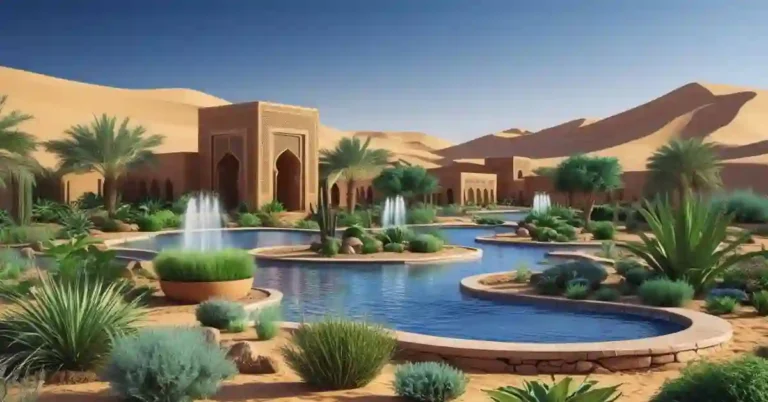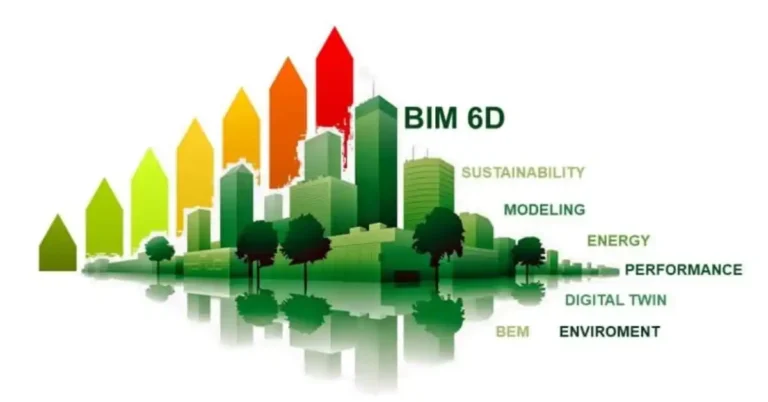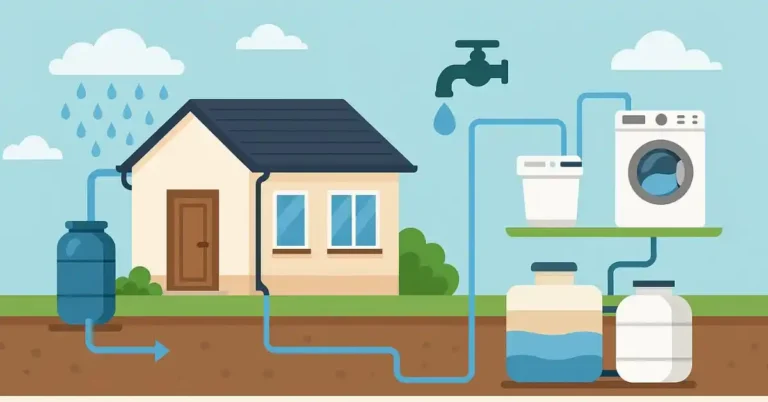What is Sustainable Building Design in Saudi Arabia?
Saudi Arabia’s skyline is undergoing a dramatic transformation, reflecting the Kingdom’s dynamic growth and ambition. Amidst this rapid development, a crucial paradigm shift is underway: the rise of sustainable building design.
Far from being just an architectural trend, sustainable design is a fundamental necessity, addressing global environmental challenges while aligning perfectly with the nation’s unique context and its forward-looking Vision 2030.
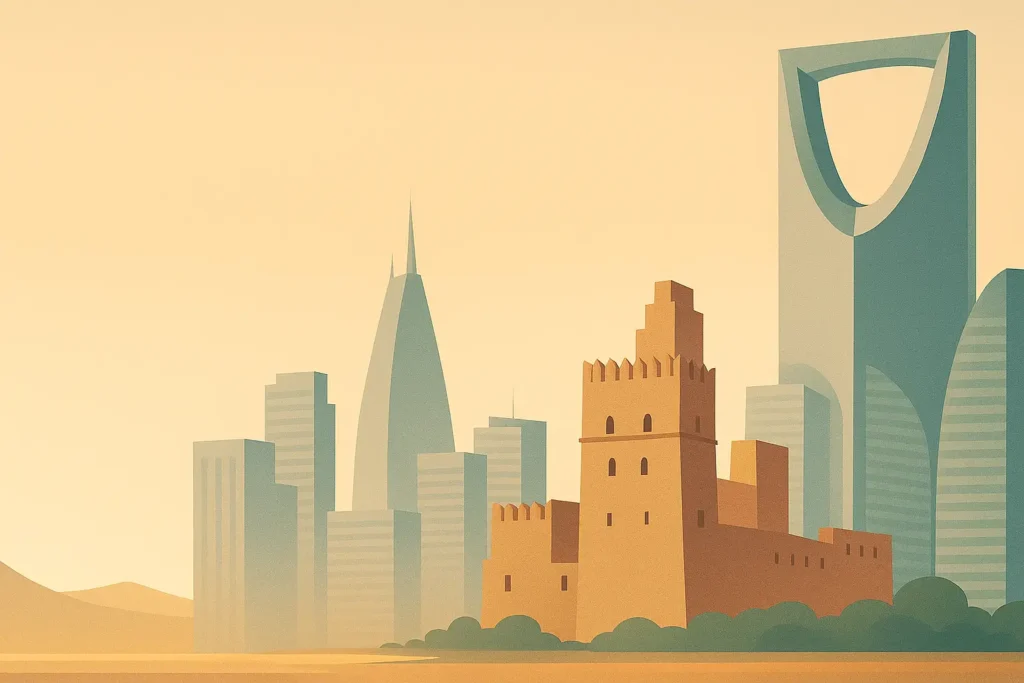
In simple terms, sustainable building design, often called green building, is the practice of creating structures and using processes that are environmentally responsible and resource-efficient throughout a building’s life-cycle: from siting to design, construction, operation, maintenance, renovation, and deconstruction.
Globally, it’s a response to pressing issues like climate change, resource depletion, and biodiversity loss. For Saudi Arabia, the relevance and urgency are amplified. The Kingdom faces a harsh climate with extreme heat and scarce rainfall, making energy and water conservation paramount.
Historically reliant on fossil fuels, the nation is actively pursuing economic diversification and environmental stewardship under Vision 2030, which emphasizes enhancing quality of life and protecting the environment for future generations.
Sustainable building design is therefore not just beneficial but essential for achieving these national goals. Sustainable building design in the Kingdom of Saudi Arabia involves the thoughtful integration of specific strategies and technologies tailored to the local environment.
Its aim is to minimize negative environmental impacts, conserve precious resources like energy and water, enhance the health and well-being of occupants, and contribute positively to the nation’s sustainable development objectives.
This article explores the core concepts, driving regulations, inherent challenges, significant opportunities, and notable examples of sustainable building design shaping Saudi Arabia’s future.
Core Concepts of Sustainable Building Design Applied to KSA
| Strategy Type | Techniques | Purpose |
|---|---|---|
| Passive Design | Building orientation, shading devices, insulation | Reduce heat gain and cooling demand |
| Active Systems | High-efficiency HVAC, LED lighting, solar PV | Optimize energy use and integrate renewables |
Sustainable building design in Saudi Arabia is not merely about adopting global trends; it is a critical response to the Kingdom’s unique environmental context and ambitious national aspirations outlined in Vision 2030.
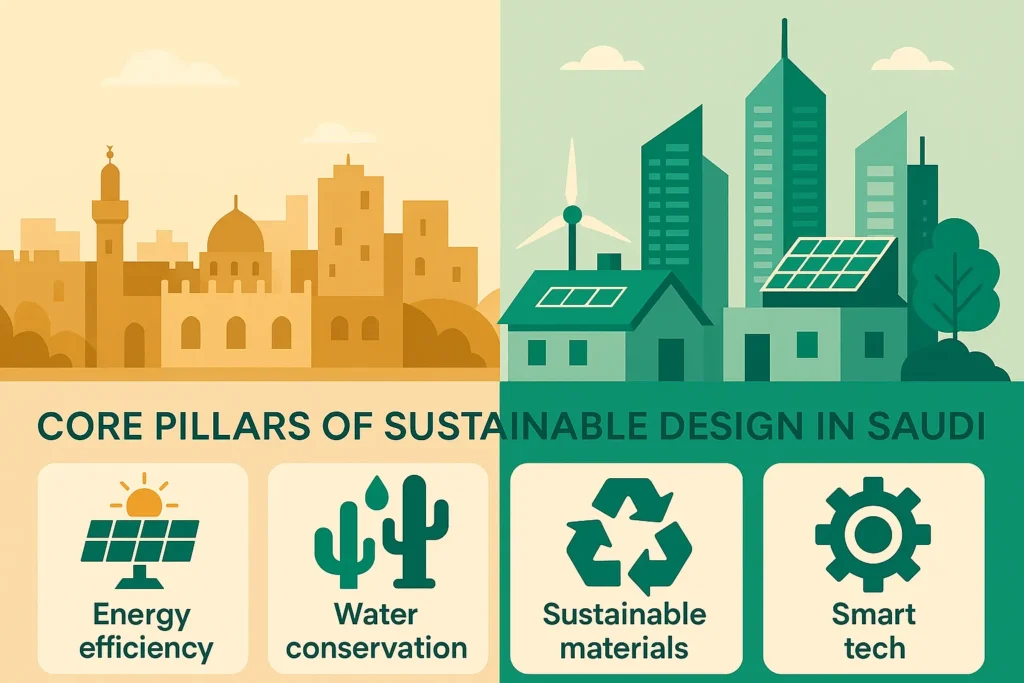
It involves a holistic approach, integrating specific strategies across various facets of design and construction to create structures that are environmentally responsible, resource-efficient, economically viable, and conducive to human health and well-being.
The core concepts underpinning this approach are adapted and prioritized to address the specific challenges and opportunities within the Saudi landscape.
Energy Efficiency: Taming the Sun and Reducing Demand
Given Saudi Arabia’s climate, characterized by intense solar radiation and high ambient temperatures for much of the year, energy efficiency is paramount. Buildings account for a significant portion of the Kingdom’s energy consumption, primarily due to cooling demands.
Sustainable design tackles this head-on through a two-pronged approach: minimizing energy demand through passive strategies and optimizing the efficiency of active systems. Passive design is the first line of defense.
This involves orienting buildings to minimize solar heat gain during peak hours, incorporating effective external shading devices (like overhangs, louvers, and mashrabiya-inspired screens), utilizing high-performance glazing, and ensuring superior insulation in walls and roofs to reduce heat transfer.
Promoting natural ventilation during cooler periods or at night can also significantly reduce reliance on mechanical cooling. These strategies work with the climate, rather than against it, reducing the building’s inherent need for energy.
Where active systems are necessary, efficiency is key. This means selecting highly efficient Heating, Ventilation, and Air Conditioning (HVAC) systems appropriately sized for the actual load (often reduced by passive measures), utilizing energy-efficient lighting solutions like LEDs combined with smart controls (daylight sensors, occupancy sensors), and choosing energy-star rated appliances.
Furthermore, the integration of renewable energy sources, particularly solar photovoltaic (PV) systems, is a cornerstone of energy strategy. Saudi Arabia’s abundant sunshine makes solar energy a highly viable option for generating clean electricity on-site, drastically reducing reliance on the grid and lowering operational costs and carbon footprint.
Water Conservation: Preserving a Precious Resource
| Technology | Application Area | Impact |
|---|---|---|
| Ultra-low-flow fixtures | Bathrooms, kitchens | Reduces potable water consumption |
| Greywater reuse systems | Toilet flushing, irrigation | Recycles wastewater for non-potable uses |
| Xeriscaping | Landscaping | Reduces irrigation water needs |
Saudi Arabia is one of the most water-scarce countries globally. Sustainable building design must therefore place an extremely high priority on water conservation. This involves minimizing consumption, maximizing reuse, and managing water resources responsibly.
Installing ultra-low-flow fixtures (taps, showerheads, toilets) is a fundamental step. Beyond fixtures, specifying water-efficient appliances like washing machines and dishwashers contributes further savings.
Water reuse strategies are increasingly important. Greywater systems, which collect water from showers, baths, and washing machines, treat it, and reuse it for non-potable purposes like toilet flushing and irrigation, offer significant potential to reduce demand for fresh potable water.
Rainwater harvesting, while challenging due to low average rainfall in many areas, can still be viable in certain regions or for specific applications, capturing precious rainfall for landscape irrigation or other non-potable uses. Equally crucial is water-wise landscaping, often referred to as Xeriscaping.
This involves selecting native or drought-tolerant plant species that thrive in the local climate with minimal irrigation, using efficient irrigation systems like drip irrigation, and employing mulching techniques to reduce evaporation.
Sustainable Materials & Resources: Building Responsibly
| Principle | Example Materials | Benefits |
|---|---|---|
| Locally sourced | Saudi limestone, clay bricks | Reduces transport emissions |
| Recycled content | Recycled steel, crushed concrete | Diverts waste from landfill |
| Low embodied carbon | Timber, green concrete alternatives | Reduces upfront carbon footprint |
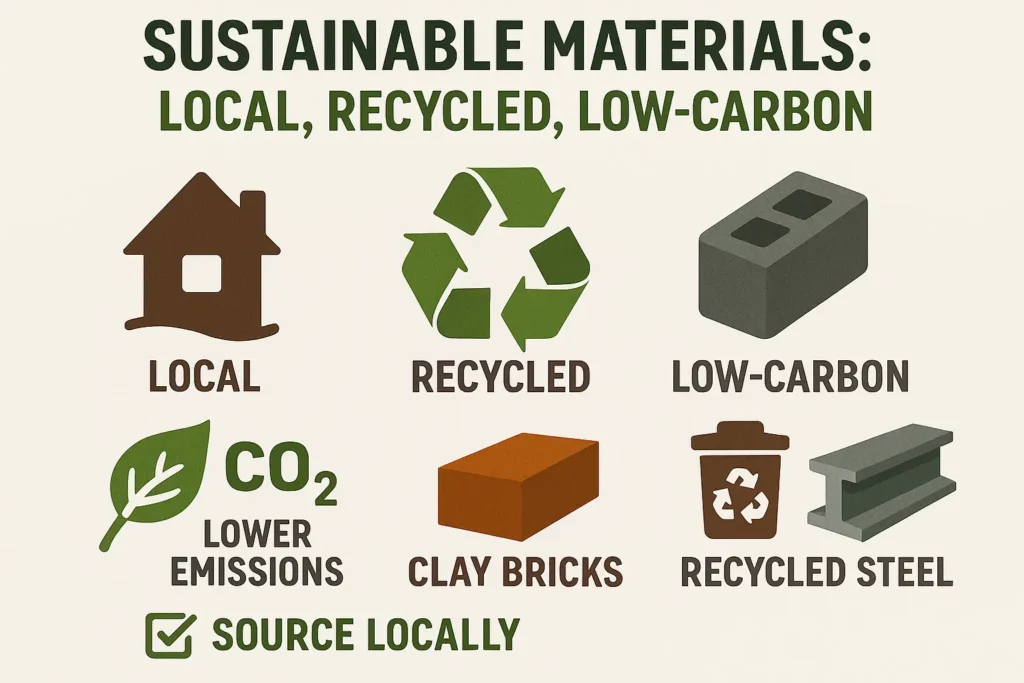
The choice of materials significantly impacts a building’s environmental footprint, from resource extraction to manufacturing, transportation, and end-of-life disposal. Sustainable design in KSA encourages the selection of materials with lower environmental impact.
Prioritizing locally sourced materials reduces transportation emissions and supports the local economy. Utilizing materials with high recycled content (like recycled steel or aggregates) diverts waste from landfills and reduces the need for virgin resources.
Specifying reclaimed materials, such as salvaged timber or bricks, adds character while conserving resources. Consideration of embodied carbon – the greenhouse gas emissions associated with material manufacturing and transport is also growing.
Choosing materials like sustainably sourced timber (where appropriate), certain types of green concrete, or innovative low-carbon alternatives helps minimize the building’s upfront carbon footprint. Durability and longevity are also key sustainability factors, especially in the harsh KSA environment; selecting materials that withstand heat, sun, and occasional sandstorms reduces the need for frequent replacement and associated waste.
Furthermore, implementing robust construction waste management plans to reduce, reuse, and recycle materials on-site is an integral part of sustainable resource management.
Indoor Environmental Quality (IEQ): Creating Healthy Spaces
| Component | Strategy | Benefit |
|---|---|---|
| Thermal Comfort | Insulation, smart HVAC | Comfortable indoor temperature |
| Air Quality | Low-VOC materials, ventilation systems | Healthier breathing environment |
| Daylighting | Window placement, light shelves | Reduces lighting energy & improves mood |
| Acoustic Comfort | Sound insulation, zoning | Reduces noise pollution |
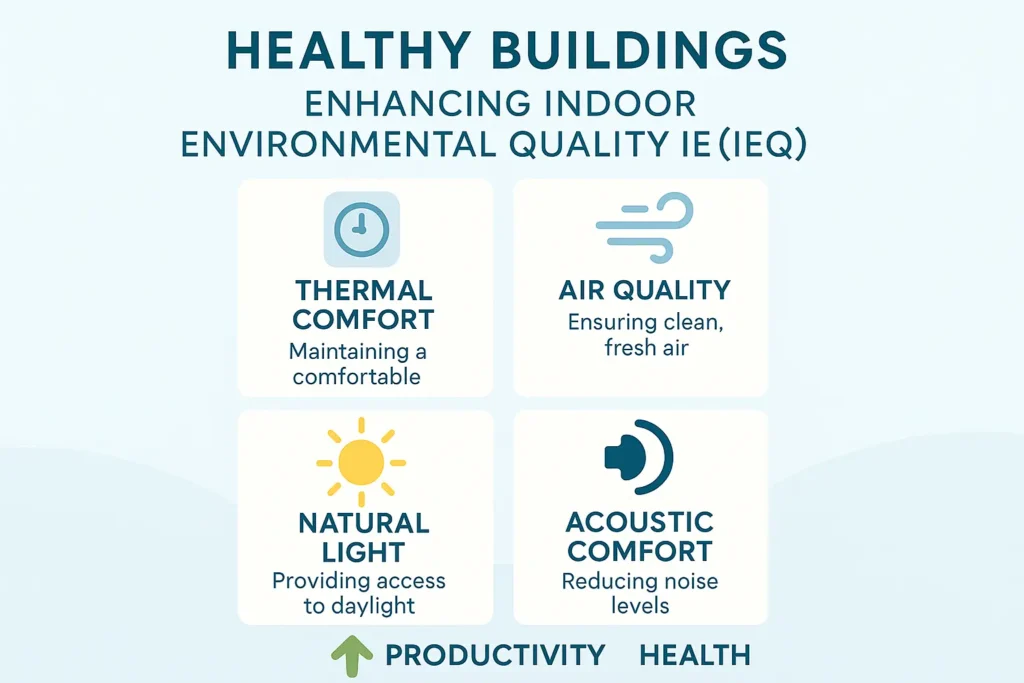
Sustainable buildings are not just about environmental protection; they are also about creating healthy, comfortable, and productive spaces for occupants. Given that people spend a significant amount of time indoors, IEQ is crucial. This encompasses several factors.
Thermal comfort is essential, achieved through the passive design strategies and efficient HVAC systems mentioned earlier, ensuring stable and comfortable indoor temperatures. Good indoor air quality is vital for health.
This is achieved through adequate ventilation (natural or mechanical with heat recovery), controlling pollutant sources, and using low-Volatile Organic Compound (low-VOC) materials (paints, adhesives, sealants, flooring) that release fewer harmful chemicals into the air.
Maximizing the use of natural daylight through careful window placement and design reduces the need for artificial lighting, saves energy, and has proven benefits for mood and productivity. Providing views to the outdoors further enhances occupant well-being. Finally, acoustic comfort, managing noise levels through appropriate insulation and space planning, contributes to a more pleasant and productive indoor environment.
Sustainable Site Development: Respecting the Land
| Focus Area | Strategy | Benefit |
|---|---|---|
| Biodiversity | Native plant selection | Enhances ecological balance |
| Stormwater Management | Permeable paving, bioswales | Reduces flood risk, recharges groundwater |
| Urban Heat Island | Green roofs, reflective surfaces | Lowers urban temperatures |
Sustainability extends beyond the building itself to how it interacts with its site and surroundings. Sustainable site development begins with careful site selection, prioritizing previously developed land or locations with good access to public transport and amenities to reduce urban sprawl and transportation needs.
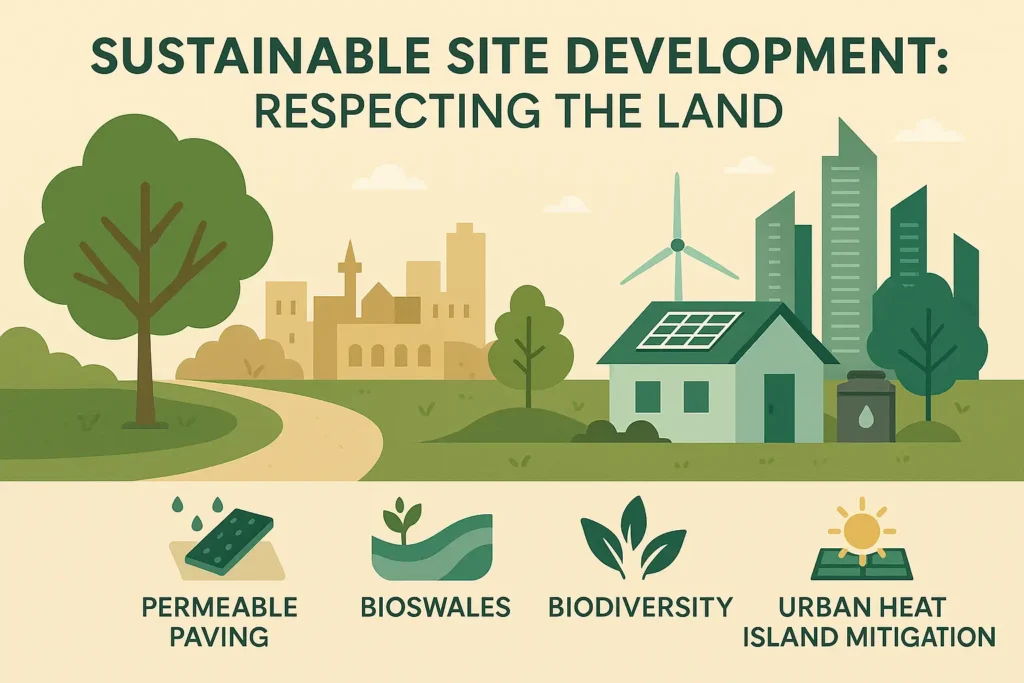
During construction, minimizing site disturbance, protecting existing vegetation, and controlling erosion are important. Managing stormwater runoff is crucial, especially during infrequent but intense rainfall events. Techniques like permeable paving, bioswales, and green roofs can help absorb rainwater, reduce runoff volume, recharge groundwater, and filter pollutants.
Protecting and enhancing local biodiversity by incorporating native planting and creating habitats is another aspect. Finally, mitigating the urban heat island effect where built-up areas become significantly hotter than surrounding rural areas is important in KSA cities.
Strategies include using reflective roofing materials, incorporating green roofs and walls, providing shade through trees and structures, and minimizing large paved areas.
Regulations, Standards, and Certifications Driving Sustainability in KSA
| Standard/System | Governing Body | Focus Areas Covered |
|---|---|---|
| SBC 601 | Saudi Building Code Authority | Energy Conservation |
| SBC 1001 | Saudi Building Code Authority | Water Efficiency |
| Mostadam | MOMRAH | KSA-tailored sustainability rating |
| LEED | USGBC | Global best practices in green design |
While understanding the core concepts of sustainable design is essential, their widespread adoption in Saudi Arabia is significantly driven by a framework of regulations, national standards, internationally recognized certifications, and supportive government initiatives.
These elements provide benchmarks, encourage best practices, and increasingly mandate higher levels of performance in the built environment, aligning construction activities with the ambitious goals of Vision 2030.
The Saudi Building Code (SBC): Setting the Baseline
The Saudi Building Code provides the fundamental regulatory requirements for construction across the Kingdom. Several parts of the SBC directly address sustainability, establishing minimum performance levels. Key among these are:
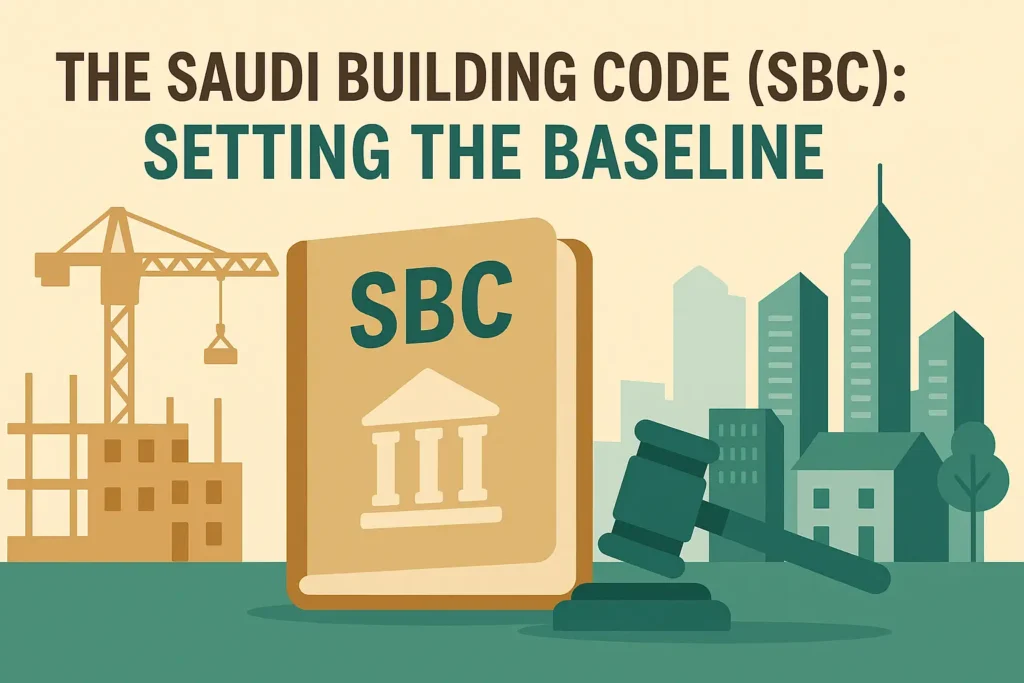
- SBC 601 (Energy Conservation): This code sets minimum requirements for the energy-efficient design and construction of buildings. It covers aspects like the thermal performance of the building envelope (walls, roofs, windows), insulation levels, glazing specifications, and the efficiency of HVAC systems, lighting, and water heating. Compliance is mandatory and aims to reduce the overall energy consumption of new buildings.
- SBC 1001 (Water Conservation): Addressing the critical issue of water scarcity, this code mandates water efficiency measures. It includes requirements for water-efficient plumbing fixtures (faucets, showerheads, toilets), limits on water consumption for certain uses, and provisions related to efficient irrigation systems for landscaping.
The SBC establishes a crucial baseline, ensuring that all new construction meets a minimum standard of energy and water efficiency. However, many sustainable projects aim to significantly exceed these minimum requirements.
Mostadam: Saudi Arabia’s National Green Building Standard
Recognizing the need for a rating system tailored specifically to the local climate, environment, building practices, and cultural context, Saudi Arabia launched Mostadam in 2019. Developed by the Sustainable Building entity under the Ministry of Municipal and Rural Affairs and Housing (MOMRAH), Mostadam provides a comprehensive framework for assessing and certifying the sustainability of buildings.
Mostadam evaluates buildings across several key categories, including Energy, Water, Materials & Waste, Health & Comfort, Site Sustainability, Innovation, and Education & Awareness. It offers different certification levels (Green, Bronze, Silver, Gold, Diamond) based on the points achieved, encouraging projects to strive for higher performance.
Mostadam is increasingly being referenced or mandated for government projects and is gaining traction in the private sector as a benchmark for sustainable development within the Kingdom. Its focus on local relevance makes it a particularly important tool for driving context-specific sustainable design.
LEED (Leadership in Energy and Environmental Design): International Influence
Before the introduction of Mostadam, LEED, developed by the U.S. Green Building Council, was the most widely adopted green building certification system in Saudi Arabia, particularly for large-scale commercial and institutional projects aiming for international recognition.
Many landmark projects, including parts of the King Abdullah Financial District (KAFD) in Riyadh, have achieved LEED certification. LEED continues to be influential in the Kingdom, offering a globally recognized standard. While Mostadam is tailored to the local context, LEED provides an established international benchmark.
Often, projects may even pursue dual certification (both LEED and Mostadam) to demonstrate both local relevance and international best practice. The presence of both systems provides choice and encourages a deeper engagement with sustainability principles across the industry.
Government Initiatives and Vision 2030
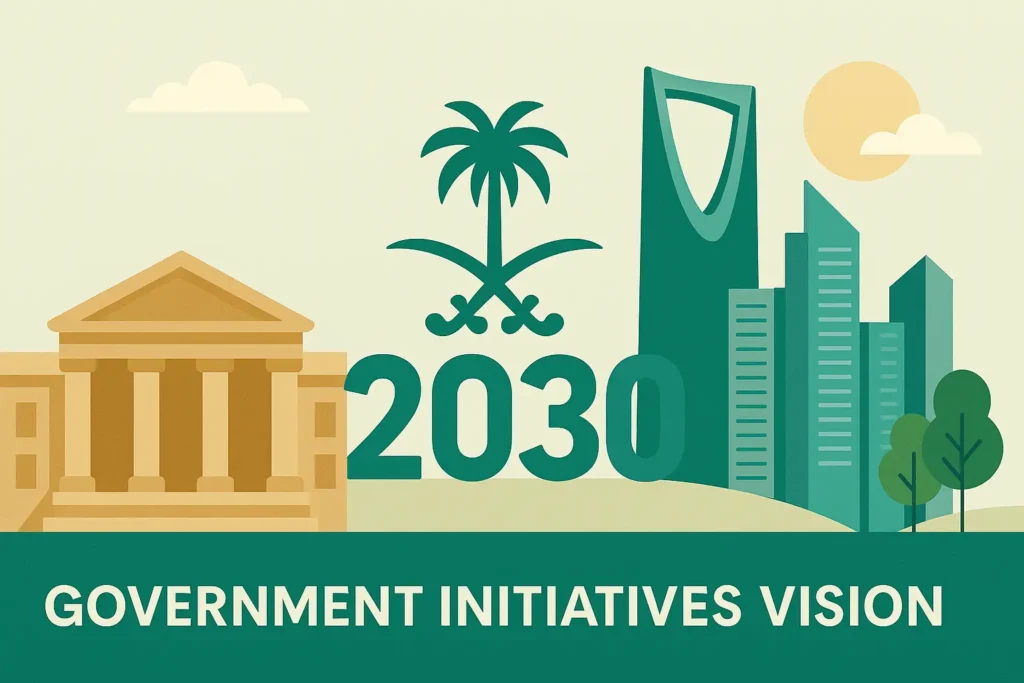
Beyond specific codes and rating systems, the overarching Saudi Vision 2030 provides significant impetus for sustainable building design. The vision’s goals related to economic diversification, environmental protection, enhancing quality of life, and developing landmark projects (like NEOM, the Red Sea Project, Qiddiya) inherently require sustainable approaches.
The Public Investment Fund (PIF), a key driver of these giga-projects, often incorporates stringent sustainability requirements into its developments, pushing the boundaries of green design and construction.
Various government programs also offer support or incentives for energy efficiency upgrades and renewable energy adoption, further encouraging sustainable practices in the built environment.
Challenges and Opportunities in Implementing Sustainable Design in KSA
| Challenges | Opportunities |
|---|---|
| High initial cost perception | Long-term savings on energy & water bills |
| Lack of technical awareness | Training programs and government incentives |
| Limited green supply chain | Growing market and giga-project demand |
| Global standards not context-adapted | Local systems like Mostadam |
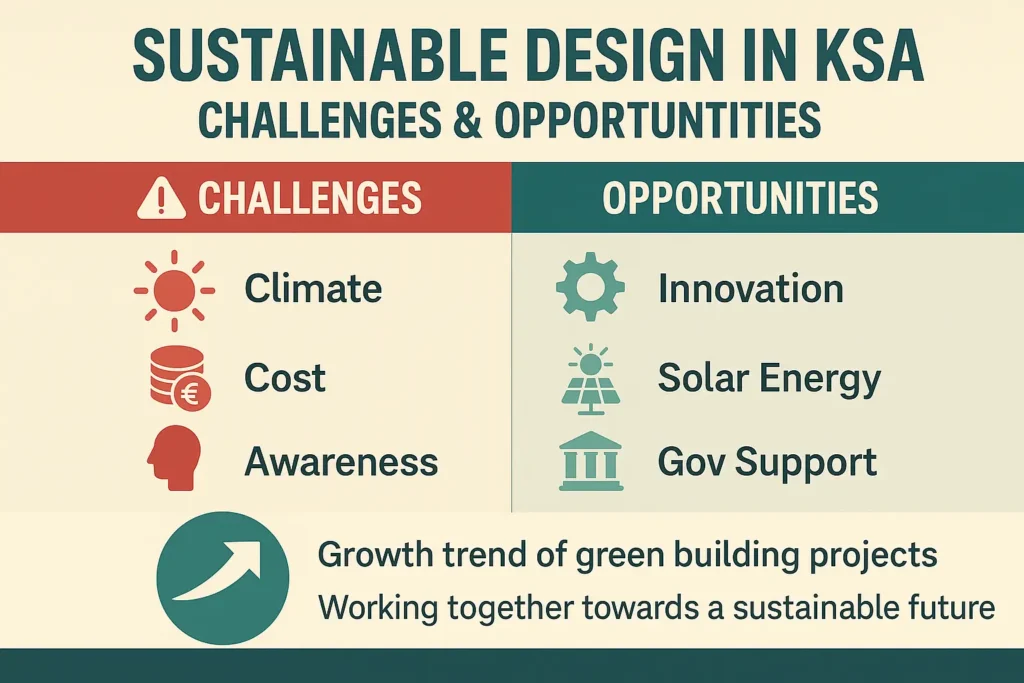
The transition towards widespread sustainable building design in Saudi Arabia, while gaining significant momentum, is not without its hurdles. However, these challenges are often counterbalanced by substantial opportunities, driven by national vision, economic factors, and technological progress.
Challenges Facing Sustainable Implementation:
- Initial Cost Perceptions: A common barrier is the perception that sustainable buildings are significantly more expensive to construct than conventional ones. While some sustainable features might involve higher upfront investment (e.g., advanced HVAC systems, solar panels), a holistic view often reveals long-term operational savings in energy and water that can offset these initial costs. Educating developers, investors, and clients about lifecycle costing is crucial to overcome this perception.
- Awareness and Expertise Gaps: While awareness is growing, there can still be a lack of deep understanding regarding sustainable principles and practices among some stakeholders, including designers, contractors, and even clients. Building capacity through training, education, and professional development programs is essential to ensure designs are implemented effectively.
- Skilled Labor: Implementing advanced sustainable technologies and construction techniques requires a workforce with specific skills. Ensuring the availability of trained labor for installing and maintaining systems like solar PV, greywater recycling, or high-performance building envelopes can be a challenge that needs addressing through vocational training initiatives.
- Adapting Global Standards: While international standards like LEED provide valuable frameworks, directly applying them without considering Saudi Arabia’s unique climate, cultural context, and available resources can be suboptimal. The development of Mostadam addresses this, but continuous adaptation and refinement of best practices for the local context are necessary.
- Supply Chain Development: The availability and cost-effectiveness of certain sustainable materials and technologies within the Kingdom can sometimes be a constraint. Developing a robust local supply chain for green building products is crucial to make sustainable options more accessible and affordable.
Opportunities Driving Sustainable Growth:
- Strong Government Support (Vision 2030): This is arguably the most significant driver. Vision 2030 explicitly prioritizes sustainability, environmental protection, and quality of life. This high-level commitment translates into supportive policies, regulatory frameworks (like the SBC and Mostadam), and significant investment in sustainable infrastructure and projects.
- Giga-Projects as Innovation Hubs: Mega-developments like NEOM, the Red Sea Project, Qiddiya, and Amaala are incorporating cutting-edge sustainability goals. These projects serve as large-scale testbeds for innovative technologies, materials, and design strategies, pushing the boundaries of what’s possible and creating demand for sustainable solutions that can then filter down to the broader market.
- Growing Market Demand: There is an increasing awareness among businesses and the public about the benefits of sustainable buildings, including lower utility bills, improved health and comfort, and enhanced corporate image. This growing demand encourages developers to incorporate green features.
- Technological Advancements: Rapid progress in areas like solar PV efficiency, smart building controls, water treatment technologies, and sustainable materials provides new and improved tools for designers and builders. The cost of technologies like solar power has also decreased significantly, making them more economically viable.
- Long-Term Operational Savings: As energy and water tariffs potentially adjust in the future, the economic benefits of resource-efficient buildings become even more pronounced. Sustainable buildings offer significant savings on utility bills over their lifespan, providing a strong financial incentive.
- Contribution to National Security: By reducing reliance on fossil fuels for energy generation and conserving precious water resources, sustainable buildings contribute directly to Saudi Arabia’s long-term energy and water security goals.
Navigating these challenges while leveraging the abundant opportunities requires collaboration between government bodies, industry professionals, academia, and the public. By addressing the hurdles and capitalizing on the drivers, Saudi Arabia is well-positioned to become a regional leader in sustainable building design and construction.
Pioneering Sustainability: Examples in Saudi Arabia
| Project | Location | Notable Sustainability Features |
|---|---|---|
| KAFD | Riyadh | LEED certified, passive facades, shading strategies |
| KAUST | Thuwal (Red Sea) | LEED Platinum, solar power, greywater reuse, passive cooling |
| NEOM – The Line | Northwestern KSA | 100% renewable energy, car-free, zero-carbon urban planning |
| Red Sea Project / Amaala | Red Sea Coast | Net positive impact, full renewable operations, marine protection |
The principles of sustainable building design are not just theoretical concepts in Saudi Arabia; they are being actively implemented in numerous projects across the Kingdom, ranging from established institutions to groundbreaking giga-projects.
These examples showcase the growing commitment to environmental responsibility and innovation in the Saudi built environment.
King Abdullah Financial District (KAFD), Riyadh:
As one of the most ambitious modern developments in Riyadh, KAFD was designed with sustainability integrated from the early stages. Many of its iconic buildings have pursued and achieved LEED certification, demonstrating adherence to international green building standards.
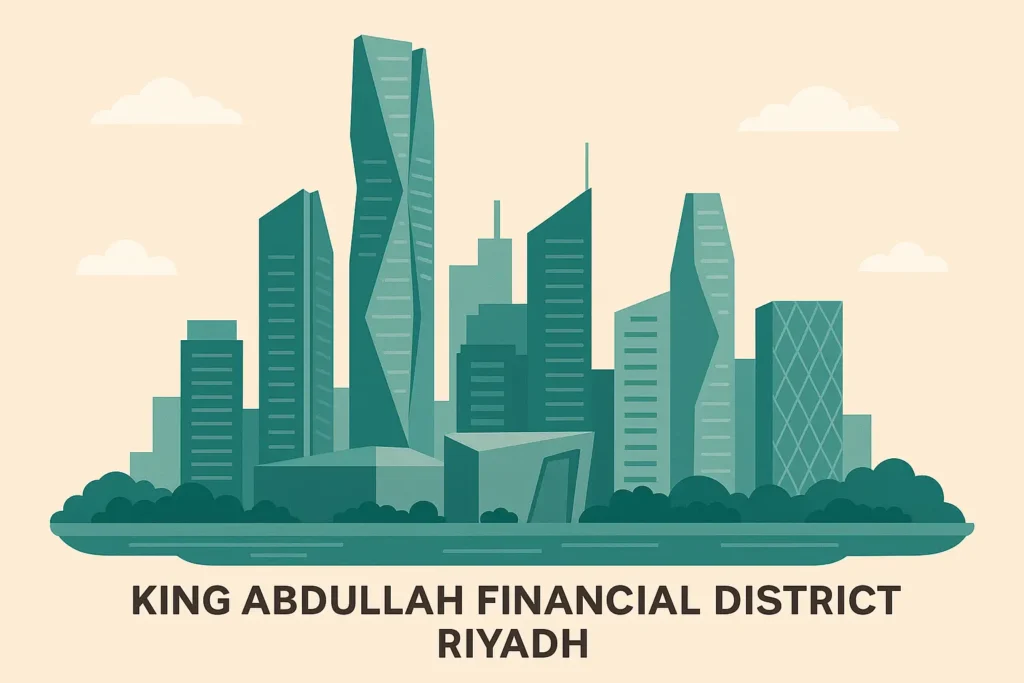
Key features include energy-efficient facade designs to combat the harsh sun, integrated shading strategies, and plans for efficient cooling systems. KAFD represents a large-scale effort to create a modern, sustainable urban hub, incorporating green spaces and prioritizing pedestrian connectivity alongside high-performance buildings.
King Abdullah University of Science and Technology (KAUST):
Located on the Red Sea coast, KAUST was an early adopter of sustainable practices in the Kingdom and achieved LEED Platinum certification for a significant portion of its campus – a remarkable feat for a project of its scale in this climate.
The campus design incorporates numerous sustainable strategies, including extensive use of solar power, highly efficient water management systems (including wastewater treatment and reuse), passive design elements to reduce cooling loads, and careful material selection.
KAUST serves as a living laboratory and a benchmark for sustainable campus development in arid environments.
Giga-Projects: Showcasing Future Ambitions
Saudi Arabia’s giga-projects, driven by the Public Investment Fund (PIF) under Vision 2030, are explicitly designed to be global showcases of sustainability and innovation:
- NEOM: Perhaps the most ambitious project, NEOM aims to be a zero-carbon city powered entirely by renewable energy sources (solar, wind, and potentially green hydrogen). Its linear city concept, “The Line,” prioritizes walkability and high-speed transit, eliminating the need for cars within the city core. NEOM plans incorporate advanced water desalination and recycling technologies, vertical farming, and construction methods focused on minimizing environmental impact.
- The Red Sea Project & Amaala: These luxury tourism destinations on the Red Sea coast are being developed with environmental regeneration and sustainability at their core. Goals include achieving a net positive conservation benefit, operating on 100% renewable energy, implementing extensive waste reduction and recycling programs, and protecting sensitive marine and terrestrial ecosystems. Sustainable design principles guide the construction of hotels, resorts, and infrastructure to minimize their footprint and enhance the natural environment.
These examples, from established financial districts and universities to futuristic cities and resorts, illustrate the diverse ways sustainable building design is taking shape in Saudi Arabia.
They demonstrate a clear trajectory towards integrating environmental considerations, resource efficiency, and technological innovation into the Kingdom’s rapidly evolving built landscape, setting precedents for future development.
Conclusion: Building a Sustainable Future for Saudi Arabia
Sustainable building design is no longer a niche concept in Saudi Arabia; it is an increasingly integral part of the Kingdom’s development narrative. Driven by the necessity to address its unique climate challenges, conserve precious resources, and achieve the ambitious goals of Vision 2030, Saudi Arabia is actively embracing practices that minimize environmental impact and enhance human well-being.
From incorporating passive design strategies and renewable energy to implementing advanced water conservation techniques and choosing low-impact materials, the core concepts of sustainability are being adapted and applied across the nation.
Regulatory frameworks like the Saudi Building Code and the locally tailored Mostadam rating system provide essential benchmarks, complemented by the influence of international standards like LEED and strong government backing.
While challenges related to cost perception, expertise, and supply chains remain, the opportunities presented by strong national will, technological innovation, and the sheer scale of development, particularly within the giga-projects, are immense.
These projects serve as powerful catalysts, pushing the boundaries of green construction and setting new standards for the region. The journey towards a fully sustainable built environment is ongoing, but the direction is clear.
By continuing to foster innovation, build capacity, and prioritize green principles in every project, Saudi Arabia is not just constructing buildings, but building a more resilient, efficient, and prosperous future for generations to come. Embracing sustainable design is a collective responsibility and a shared investment in the Kingdom’s long-term health and vitality.

